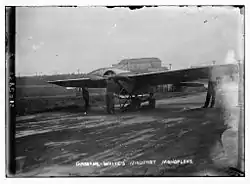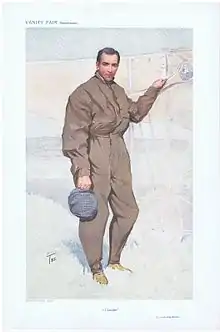Claude Grahame-White | |
|---|---|
_LCCN2014685332_(cropped).jpg.webp) Grahame-White in 1910 | |
| Born | 21 August 1879 |
| Died | 19 August 1959 (aged 79) Nice, France |
| Spouse(s) | Dorothy Caldwell Taylor (m. 1912, dissolved 1916) Ethel Levey (m. 1916, div 1939) Phoebe Lee (1939) |
Claude Grahame-White (21 August 1879 – 19 August 1959) was an English pioneer of aviation, and the first to make a night flight, during the Daily Mail-sponsored 1910 London to Manchester air race.
Early life
Claude Grahame-White was born in Bursledon, Hampshire in England on 21 August 1879, and educated at Bedford Grammar School.[1] He learned to drive in 1895, was apprenticed as an engineer and later started his own motor engineering company.
Aviation career
Grahame-White's interest in aviation was sparked by Louis Blériot's crossing of the English Channel in 1909. This prompted him to go to France, where he attended the Reims aviation meeting, at which he met Blériot and subsequently enrolled at his flying school.[1]
Grahame-White was one of the first people to qualify as pilot in England, becoming the holder of Royal Aero Club certificate No. 6, awarded in April 1910.[2] He became a celebrity in England in April 1910 when he competed with the French pilot Louis Paulhan for the £10,000 prize offered by the Daily Mail newspaper for the first flight between London and Manchester in under 24 hours. Although Paulhan won the prize, Grahame White's achievement was widely praised.

On 2 July 1910, Claude Grahame-White, in his Farman III biplane, won the £1,000 first prize for Aggregate Duration in Flight (1 hr 23 min 20 secs) at the Midlands Aviation Meeting at Wolverhampton.[3] In the same year he won the Gordon Bennett Aviation Cup race in Belmont Park, Long Island, New York, for which he was awarded the Gold Medal of the Royal Aero Club. [4]
On 14 October 1910 while in Washington, D.C. Grahame-White flew his Farman biplane over the city and landed on West Executive Avenue near the White House.[5] Rather than being arrested Grahame-White was applauded for the feat by the newspapers.[6]
On 26 September 1911 at an International Air Meet at Nassau Boulevard Long Island New York attended by Eugene Ely, George W. Beatty, Harry Atwood, Bud Mars, J. A. D. MucCurdy and Matilda Moissant, Grahame-White won a prize of $600.00 in a speed contest for flying his monoplane ten miles at a speed of 61 and 1/2 miles per hour.[7]
He is known for activities related to the commercialisation of aviation, and he was also involved in promoting the military application of air power before the First World War with a campaign called "Wake Up Britain", also experimenting with fitting various weapons and bombs to aircraft. During the war itself he flew the first night patrol mission against an expected German raid on 5 September 1914.[8]
Grahame-White trained several women to fly and he had formed the Women's Aerial League in 1909. The membership of this league included test pilot Mrs Winifred Buller, Lady Anne Savile and Eleanor Trehawke Davies and the suffragette leaders Emmeline and Christabel Pankhurst.[9] He established a flying school at Hendon Aerodrome. Cheridah de Beauvoir Stocks, the second British woman to gain a Royal Aero Club aviator's licence, trained at the school, earning her certificate in November 1911.[10] In 1912 Grahame-White gave H.G. Wells his first flight.[11] The Aerodrome was lent to the Admiralty (1916), and eventually taken over by the RAF in 1919. Grahame-White's aerodrome was purchased by the RAF in 1925, after a protracted legal struggle. After this he lost his interest in aviation, eventually moving to Nice in his old age, where he died in 1959 having made a fortune in property development in the UK and US.[1]

Hendon Aerodrome later became RAF Hendon but after flying ceased there in the 1960s it was then largely redeveloped as a housing estate which was named Grahame Park in tribute to Grahame-White. An original World War I Grahame-White aircraft factory hangar was relocated a few years ago to the Royal Air Force Museum London, where it houses the museum's World War I collection and is named the Grahame White Factory.
Grahame-White was a co-founder of Aerofilms Limited in 1919.
Grahame-White Aviation Company

In 1911 The Grahame-White Aviation Company was formed to cover his aviation interests, including aerodromes and aircraft design, development, and construction. One of the designers, John Dudley North, became Boulton & Paul's chief designer.
Aircraft built by the Grahame-White Aviation Company included:
- Grahame-White Baby
- Grahame-White Type VI
- Grahame-White Type VII "Popular"
- Grahame-White Type IX Monoplane[12]
- Grahame-White Type X Charabanc
- Grahame-White "Lizzie"[13]
- Grahame-White Type XI
- Grahame-White Type XIII Circuit of Britain biplane/scout
- Grahame-White Type XIV (License-built Morane-Saulnier G)
- Grahame-White Type XV
- Grahame-White Type 18[14]
- Grahame-White G.W.19 (License-built Breguet Bre.5)
- Grahame-White Type 20 Scout (Prototype only)
- Grahame-White Type 21 Scout (Prototype only)[15]
- Grahame-White Sommer-biplane[16]
- Grahame-White G.W.E.IV Ganymede
- Grahame-White G.W.E.VI Bantam
- Grahame-White G.W.E.VII Limousine
Publications
As well as his success in aviation, Claude Grahame-White was a published author whose works include:
- The Story of the Aeroplane[17]
- The Aeroplane, Past, Present, and Future, 1911[18]
- The Aeroplane in War[19]
- Aviation, 1912[20]
- Learning to Fly, 1914[21]
- Aircraft in the Great War, 1915[22]
- Air Power, 1917[23]
- Our First Airways, their Organisation, Equipment, and Finance, 1918[24]
- Heroes of the Air[25]
- With the Airmen[26]
- The Air King’s Treasure
- The Invisible War-Plane
- Heroes of the Flying Corps[27]
- Flying, an Epitome and a Forecast, 1930
He also contributed to newspapers, reviews, and magazines, dealing with aeronautics in the military and commercial fields.
See also
References
- 1 2 3 Grimsditch, H. B. (May 2008) [2004]. "White, Claude Grahame- (1879–1959), rev. Robin Higham". Oxford Dictionary of National Biography. Oxford Dictionary of National Biography (online ed.). Oxford University Press. doi:10.1093/ref:odnb/33512. Retrieved 19 May 2010. (Subscription or UK public library membership required.)
- ↑ Aviator's certificates Flight 30 April 1910
- ↑ "The Wolverhampton Meeting," in The Times, Monday 4 July 1910, p. 9 columns B–C.
- ↑ "Awards & Trophies: Gold Medal of the Royal Aero Club". Royal Aero Club. 2009. Archived from the original on 16 July 2011. Retrieved 19 June 2010.
- ↑ Tom (14 March 2012). "British Aeronaut Lands Biplane Between War Department and West Wing". Ghosts of DC. Retrieved 3 March 2019.
- ↑ Tom D. Crouch. "Aero Club of Washington: Aviation in the Nation's Capital, 1909–1914": 46.
{{cite journal}}: Cite journal requires|journal=(help) - ↑ The Richmond Times Dispatch Sept 26, 1911 p. 1
- ↑ Cole, Christopher and E.F. Cheeseman. The Air Defence of Great Britain 1914–1918: London: Putnam, 1984. ISBN 0370305388, p. 7
- ↑ "Flying and Votes for Women" (PDF). Royal Air Force Museum. 2013. Retrieved 2 May 2022.
- ↑ "Genealogy Reviews". genealogyreviews.co.uk. Retrieved 15 October 2021.
- ↑ Michael Sherborne, H.G. Wells: Another Kind of Life (Peter Owen, 2010), p. 216. Wells enthusiastically described the experience in a short piece entitled "My First Flight," later reprinted in An Englishman Looks at the World (1914).
- ↑ Type IX (dated 1912) at aircraft-catalog.com Accessed 13 March 2017
- ↑ Four pictures of the "Lizzie" (dated 1913 and '1914 after extended lower wings fitted') at flyingmachines.ru Accessed 13 March 2017
- ↑ Picture of 'The sole Grahame-White Type 18 prototype, before covering' (dated ~1916) at flyingmachines.ru Accessed 13 March 2017
- ↑ Picture of Grahame-White Type 21 (Scout), dated 1917, at aviadejavu.ru Accessed 13 March 2017
- ↑ Grahame-White Sommer-biplane at aircraft-catalog.com Accessed 13 March 2017
- ↑ Grahame-White, Claude (1911). The Story of the Aeroplane. Boston: Small, Maynard and Company. Retrieved 14 February 2022.
- ↑ Grahame-White, Claude; Harper, Harry (1911). The Aeroplane: Past, Present, and Future. Philadelphia: J. B. Lippincott Company. Retrieved 14 February 2022.
- ↑ Grahame-White, Claude; Harper, Harry (1912). The Aeroplane in War. Philadelphia: J. B. Lippincott Company. Retrieved 14 February 2022.
- ↑ Grahame-White, Claude (1912). Aviation. London: Collins' Clear Type Press. Retrieved 14 February 2022.
- ↑ Grahame-White, Claude; Harper, Harry. Learning to Fly: A Practical Manual for Beginners. New York: Macmillan Company. Retrieved 14 February 2022.
- ↑ Grahame-White, Claude; Harper, Harry. Aircraft in the Great War: A Record and Study. London: T Fisher Unwin. Retrieved 14 February 2022.
- ↑ Grahame-White, Claude; Harper, Harry (1917). Air Power: Naval, Military, Commercial. London: Chapman & Hall. Retrieved 14 February 2022.
- ↑ Grahame-White, Claude; Harper, Harry. Our First Airways: Their Organization, Equipment, and Finance. London: John Lane, The Bodley Head. Retrieved 14 February 2022.
- ↑ Grahame-White, Claude (1912). Heroes of the Air: A Book for Boys. London: Henry Frowde Hodder and Stoughton. Retrieved 14 February 2022.
- ↑ Grahame-White, Claude; Harper, Harry. With the Airmen. London: Henry Frowde Hodder and Stoughton. Retrieved 14 February 2022.
- ↑ Grahame-White, Claude; Harper, Harry (1916). Heroes of the Flying Corps: A Description of the Work of the Airmen During the Early Stages of the War. London: Henry Frowde Hodder and Stoughton. Retrieved 14 February 2022.
External links
- Works by Claude Grahame-White at Project Gutenberg
- Works by or about Claude Grahame-White at Internet Archive
- Works by Claude Grahame-White at LibriVox (public domain audiobooks)

- The restoration of Claude Grahame-White's aviation building begins after 20yrs of neglect BBC programme – Rebuilding Our Past: Hendon
- Brick by Brick: Rebuilding Our Past:Hendon at IMDb
- Claude Grahame-White at Find a Grave